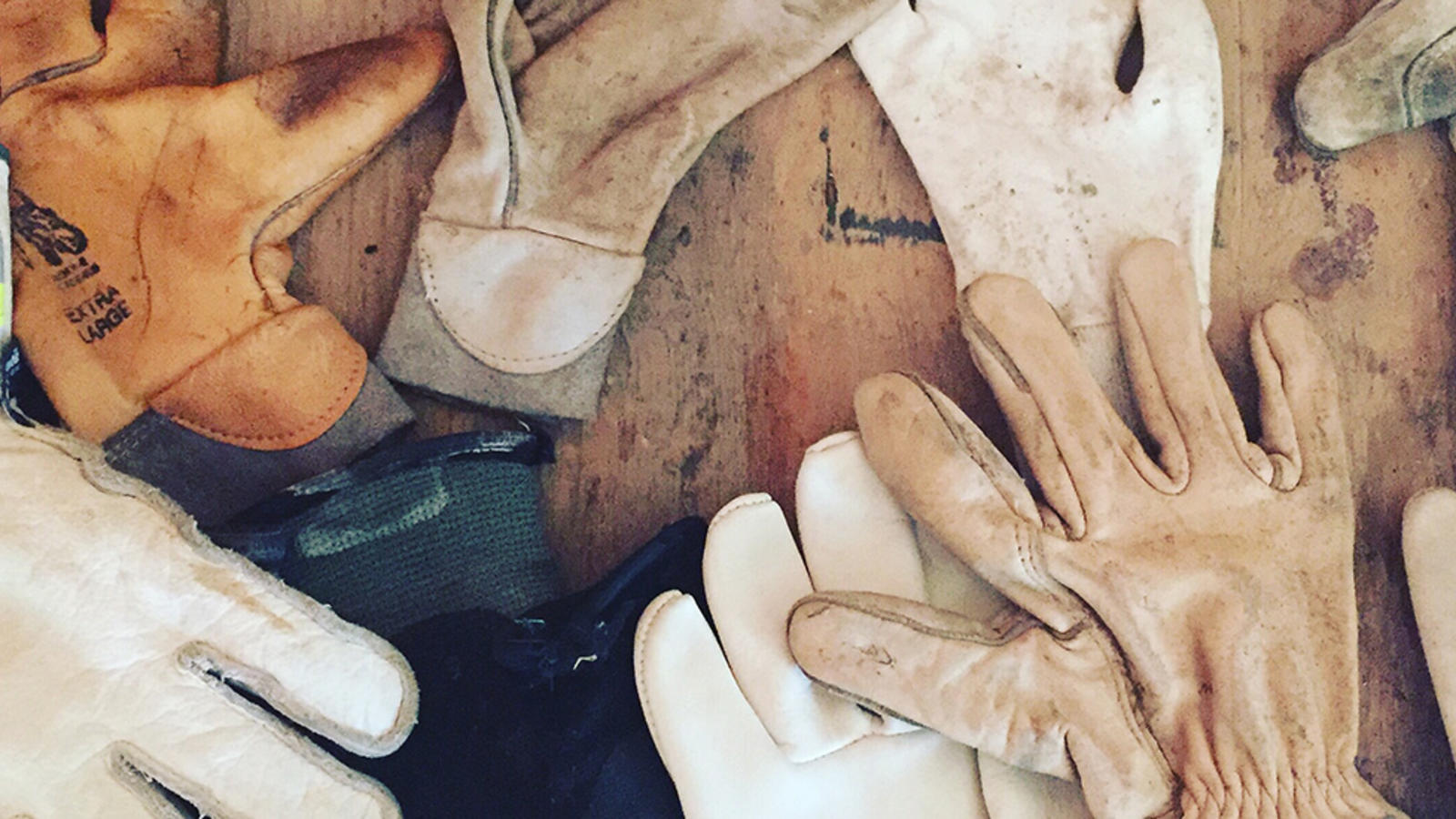
Whistle While You Work
An Industry In Crisis: How C3 Is Trying To Do Right By Its Workers
By Allyn West
An Industry In Crisis: How C3 Is Trying To Do Right By Its Workers
The following story originally appeared in Cite: The Architecture and Design Review of Houston, 98: The Finance Issue, Spring 2016, under the title “An Industry in Crisis" by Allyn West.
Hermen Valdez realized that he wasn’t going to be able to afford to get back to Texas. His oldest son, a Houston native, was set to graduate from Baylor, and Valdez needed a plane ticket.
But he also needed to make payroll that month.
Valdez, who had moved away in the late 1980s from the recession in Houston to New England in search of more steady construction work, was an independent contractor, responsible for the salaries and insurance payments and taxes on a crew of about 20 general and skilled laborers.
He started working in the construction industry in high school. Before that, since he was 10, he had been helping his parents as a manual laborer. He grew up a few hundred miles southeast of Seattle, where his parents settled after emigrating from Mexico. When he graduated from high school in the late 1970s, he heard there were opportunities in Houston, then in one of its booms. Developers like Hines were financing big commercial projects Downtown, and the Medical Center was expanding. You could move to Houston, build buildings, start a family — and that’s what Valdez did.
The recession forced him north to hustle for work in a new part of the country. There, the competition of the free market wasn’t always friendly. Running his business out of the passenger seat of his truck, Valdez often bid lower on jobs than most union shops, and he allows that some stooped to intimidation to drive him out. “The unions made me miserable,” he says. The tires of his truck were regularly slashed. Once, says Valdez, a story was fed to a small Massachusetts newspaper that alleged he was forcing his workers to share a cramped apartment, implying that he was engaged in human trafficking. It wasn’t true, but there wasn’t much Valdez could do. Hiring a lawyer to file a libel suit and collect damages wasn’t in his budget.
Telling these stories now, Valdez shrugs. What choice did he have? He put up with the forced itinerancy. The intimidation.
The 70-hour weeks. After 16 years of having to live and work away from his family, his marriage ended. He began to realize that he wasn’t saving nearly enough for retirement. Eventually, he arrived at the dilemma that would drive him back to Houston: He could pay his workers, or he could see his son get his college degree.
He had to let his son down.
“That was the last straw,” he says.
Such difficulties and indignities are not uncommon among career construction workers. Even as building booms again in Texas, where one in 13 workers is employed in the industry, where Austin, Houston, San Antonio, and Dallas are considered among the fastest-growing cities in the country, the industry still promises but a low quality of life for many of its workers and struggles, at the same time, to recruit young people who no longer see the building trades as a means to the middle class.
A survey of almost 1,200 construction workers in Texas, compiled in 2013 by professors at the University of Texas, University of Illinois at Chicago and researchers with the Workers Defense Project (WDP) in Austin, show an industry today that is compromised by low wages, lack of benefits, job insecurity, unsafe working conditions and little to no continuing education or vocational training. Only 18 percent of the workers surveyed reported that they had received training on a job; 22 percent reported some form of wage theft; 52 percent reported earnings below the federal poverty line; and 78 percent reported that they are not covered by employer-based medical insurance.
One of the industry’s most insidious problems is payroll fraud, with employees being misclassified as independent contractors. Doing so allows employers to avoid paying Social Security and payroll taxes and providing overtime pay, benefits, insurance and unemployment for their workers — which, in turn, allows these employers to make lower and lower bids on jobs “in a race to the bottom.” (Meanwhile, law-abiding employers complain they can’t compete in such a race.)
The pretense is that an “independent contractor,” as the self-employed owner of a small business — his own body, that is — should be responsible for setting aside, out of hourly wages that rarely surpass $15, his own taxes, insurance premiums and payments into a retirement plan. (Not to mention provide access to his own safety equipment, tools, etc.)
The WDP estimates that, in Texas, as much as 40 percent of the construction workforce — or upward of 400,000 people — is thus misclassified. Worse, many others are paid in cash “under the table.” This leads to an estimated $1.6 billion every year in unpaid federal income taxes.
Texas is also the most dangerous state to work in, with the highest fatality rate in the country. The WDP found that as many as 20 percent of workers surveyed reported at least one workplace injury that required medical attention; 60 percent reported never having received basic safety training. Meanwhile, employers in Texas are not required to provide workers’ compensation. For that matter, they are not required, in this hot and humid state, even to provide water breaks.
These problems have led to an industry in something of a crisis. Leaders describe a shortage of skilled workers, which drives costs higher, as jobs take longer to complete. When they are completed, they are not always jobs done well.
Owners spend as much as 90 percent more than the initial cost on repairs and maintenance over the life of the building.
“This is the most complex business problem I’ve ever seen in my life,” says Chuck Gremillion. “It’s not just a workforce problem. It’s a human problem.” A native Houstonian, Gremillion has experienced the city’s busts and booms. He witnessed the collapse of the economy in the 1980s that drove Valdez and others like him away in search of work. He witnessed how the industry was soon forced to cut costs and became, as he says, “bottom-line driven.”
First, says Gremillion, members of unions — one of the last places where workers can receive “formalized training” — were deemed too expensive. Then, even hourly workers were deemed too expensive; they started to be misclassified as “independent contractors” — given 1099s instead of W2s — and paid by the piece. Often, they were fired if they complained, fired if they were hurt. For decades, now, the industry has confused its people with its tools, treating them with indifference and neglecting their upkeep, then casting them aside when they break down. “Some owners look the other way, shooting themselves in the foot in the long run.”
In 2009, this crisis led five industry leaders — the top executives from Vaughn Construction, Marek Companies, W.S. Bellows Construction, Associated General Contractors–Houston and Chamberlin Roofing & Waterproofing — to establish a nonprofit initiative that they called the Construction Career Collaborative (C3). Gremillion now serves as C3’s Executive Director. C3, explains Gremillion, intends to revive the industry’s reputation and restore the building trades as middle-class occupations. That’s done primarily, he says, through the participation of owners — including M.D. Anderson Cancer Center, Memorial Hermann Health System, Texas Children’s Hospital and The Museum of Fine Arts, Houston.
“It’s the right thing to do for a lot of reasons,” says Peter Dawson, AIA, Senior Vice President of Facilities Services at Texas Children’s. Building with C3 accreditation was, for Texas Children’s, a way to support a “social value.” But it was also a business decision with at least a few important considerations. Primarily, Dawson explains, it was a way of leading the industry forward: the growth of Texas Children’s depends directly on the growth of a skilled workforce. “It costs a lot to build a hospital,” he says. “It has a lot of systems — mechanical, electrical — that are sophisticated. In order to get a building like that built, you have to be able to call on different trades and different levels of skilled labor [that] can do highly specialized work effectively and correctly. [Working with C3] is encouraging a marketplace of these skills.”
If LEED measures the energy and resource efficiency of a building, C3 accreditation might measure the quality of workplace for the people who built it. “Ultimately,” predicts Dawson, “C3 will become the standard for construction.” A building built with C3 accreditation means that the contractors of record have submitted signed agreements with 14 “assurances” about payroll compliance, workers’ compensation, safety training and more. Contractors must provide assurances that their employees are paid by the hour, given overtime according to federal law and are designated as W2-receiving employees, not 1099-receiving “independent contractors.” They are also required to provide OSHA 10-hour safety training for workers and 30-hour training for supervisors. Additionally, C3 conducts spot audits to reinforce these assurances — which are further reinforced by annual accreditation fees. Contractors can pay $1,500 for an entire job or pay a range, from $100 to $2,000, for specialty work.
Though these provisions ensure better conditions for the workers employed by C3-accredited companies, many of which are the largest and longest-running general and specialty contractors in Houston, the overall sustainability of the industry remains uncertain — suffering, as Gremillion describes it, from a “perception problem.”
“Young people don’t see it as a path to the middle class. More people are recognizing that the problem exists,” says Gremillion. “But we are just scratching the surface.” As Gremillion explains, those workers trained by unions — the last generation of skilled laborers — have now reached retirement age. Where will the next generation come from? Policies resulting from the No Child Left Behind Act in 2001 have added more urgency to that question. Funding, scarce in education to begin with, went to support preparation for standardized testing — that is, preparation for college. Cuts to arts and music programs are the ones that receive the most outrage, but cuts to vocational and technical programs limit career opportunities as well.
Additionally, 40 to 50 percent of the construction industry is made up of undocumented workers. C3, as Gremillion explains, doesn’t take a stance on immigration policies. “We train the workers we have,” he says. But it’s clear that a worker’s lack of documentation would be incompatible with the payroll practices — which demand transparency, aside from local, state and federal compliance — that C3 advocates.
Still, it’s clear that C3 is working for a skilled laborer like Valdez. Since moving back to Houston in the late 2000s, Valdez landed with Marek Companies, a C3-accredited employer. “I started all the way back at the bottom,” he explains. But he has since moved up to become a general foreman, and he spends his days planning meetings and coordinating among the laborers, engineers, architects and owners on a job site. Marek pays him an hourly wage and guarantees a 40-hour week. Marek pays into a retirement account and provides vacation time, healthcare and insurance in case he’s injured.
Marek also provides classes after hours, in English and in Spanish, for skilled workers and site supervisors like him — and such continuing education provides these employees a way to advance and increase their earning potential.
Valdez is working, now, on a new patient tower for Methodist Hospital in Sugar Land, where Vaughn Construction is the general contractor. Every morning, Valdez drives in and forms a huddle at the job site. The employees — who will spend their day framing walls, hanging drywall, sealing the seams, painting, wiring and installing the floors — hear from him about safety procedures. About production issues. About quality. Those who will bend and hoist 100-pound panels of drywall into place review proper lifting techniques and are even led through a stretching routine. In other industries, that wouldn’t be news. It wouldn’t be worth noting. But on the construction sites where Valdez has spent his entire career, and his entire adult life, it is.
Never Miss A Story


